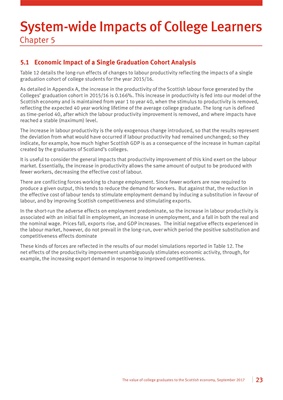
23
The value of college graduates to the Scottish economy, September 2017
5.1 Economic Impact of a Single Graduation Cohort Analysis
Table 12 details the long-run effects of changes to labour productivity reflecting the impacts of a single
graduation cohort of college students for the year 2015/16.
As detailed in Appendix A, the increase in the productivity of the Scottish labour force generated by the
Colleges' graduation cohort in 2015/16 is 0.166%. This increase in productivity is fed into our model of the
Scottish economy and is maintained from year 1 to year 40, when the stimulus to productivity is removed,
reflecting the expected 40 year working lifetime of the average college graduate. The long run is defined
as time-period 40, after which the labour productivity improvement is removed, and where impacts have
reached a stable (maximum) level.
The increase in labour productivity is the only exogenous change introduced, so that the results represent
the deviation from what would have occurred if labour productivity had remained unchanged; so they
indicate, for example, how much higher Scottish GDP is as a consequence of the increase in human capital
created by the graduates of Scotland's colleges.
It is useful to consider the general impacts that productivity improvement of this kind exert on the labour
market. Essentially, the increase in productivity allows the same amount of output to be produced with
fewer workers, decreasing the effective cost of labour.
There are conflicting forces working to change employment. Since fewer workers are now required to
produce a given output, this tends to reduce the demand for workers. But against that, the reduction in
the effective cost of labour tends to stimulate employment demand by inducing a substitution in favour of
labour, and by improving Scottish competitiveness and stimulating exports.
In the short-run the adverse effects on employment predominate, so the increase in labour productivity is
associated with an initial fall in employment, an increase in unemployment, and a fall in both the real and
the nominal wage. Prices fall, exports rise, and GDP increases. The initial negative effects experienced in
the labour market, however, do not prevail in the long-run, over which period the positive substitution and
competitiveness effects dominate
These kinds of forces are reflected in the results of our model simulations reported in Table 12. The
net effects of the productivity improvement unambiguously stimulates economic activity, through, for
example, the increasing export demand in response to improved competitiveness.
System-wide Impacts of College Learners
Chapter 5